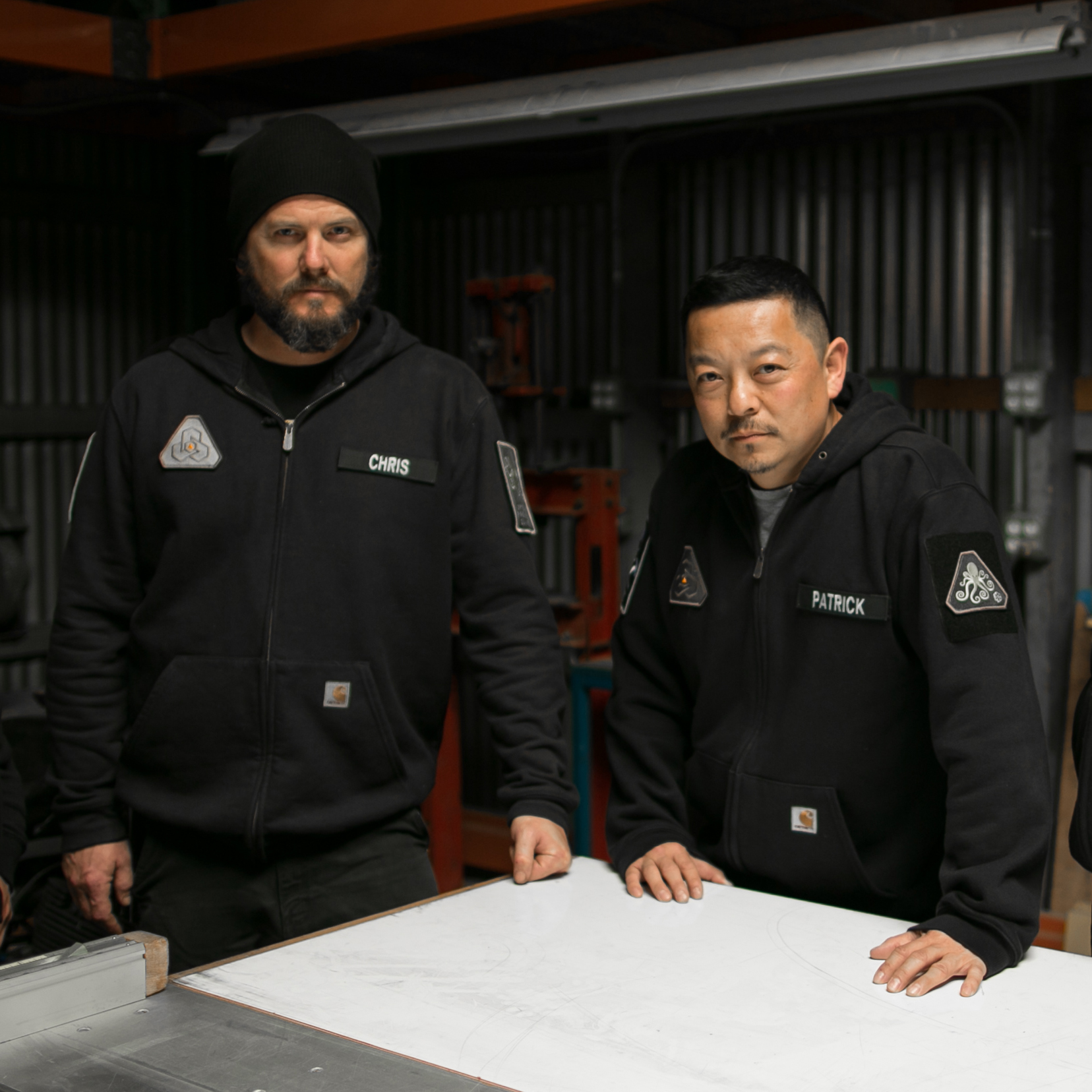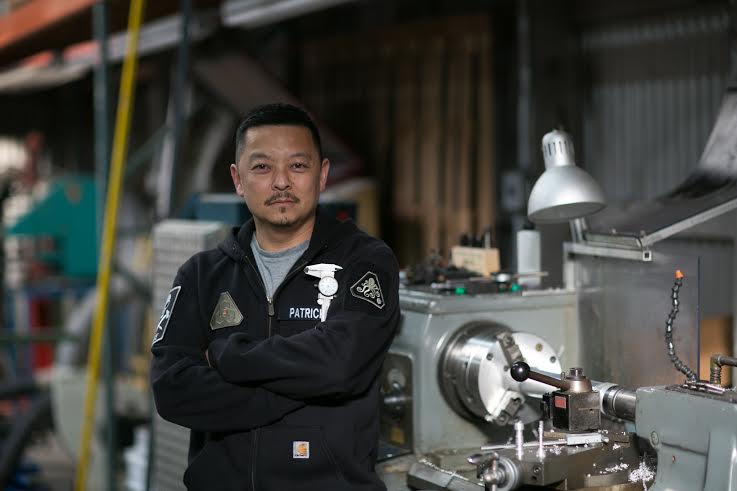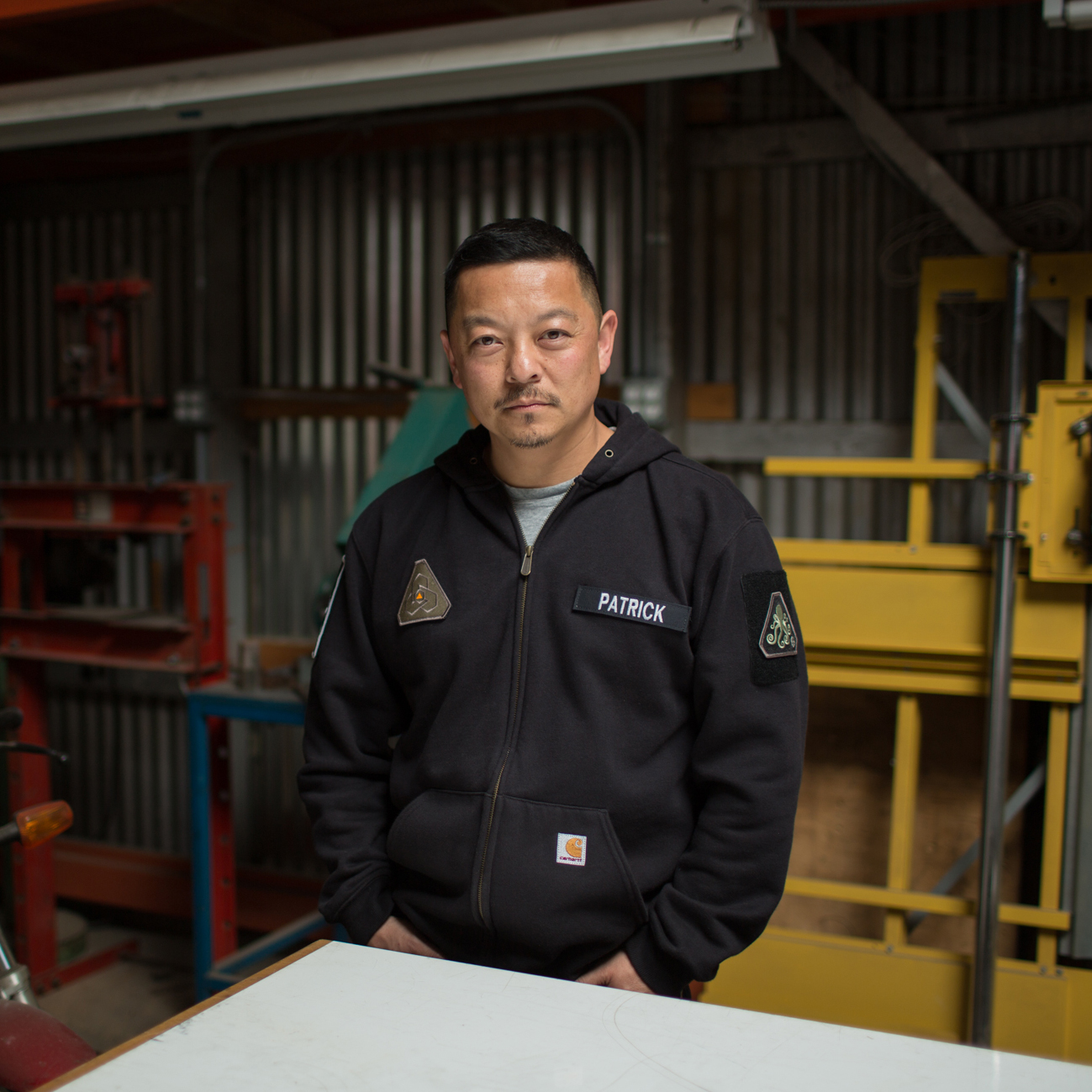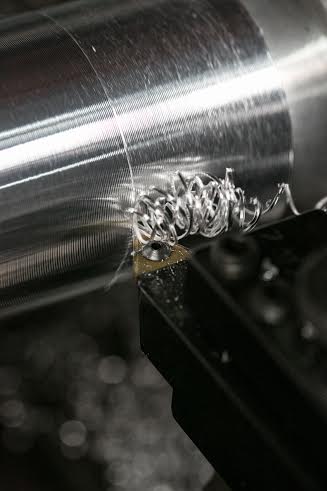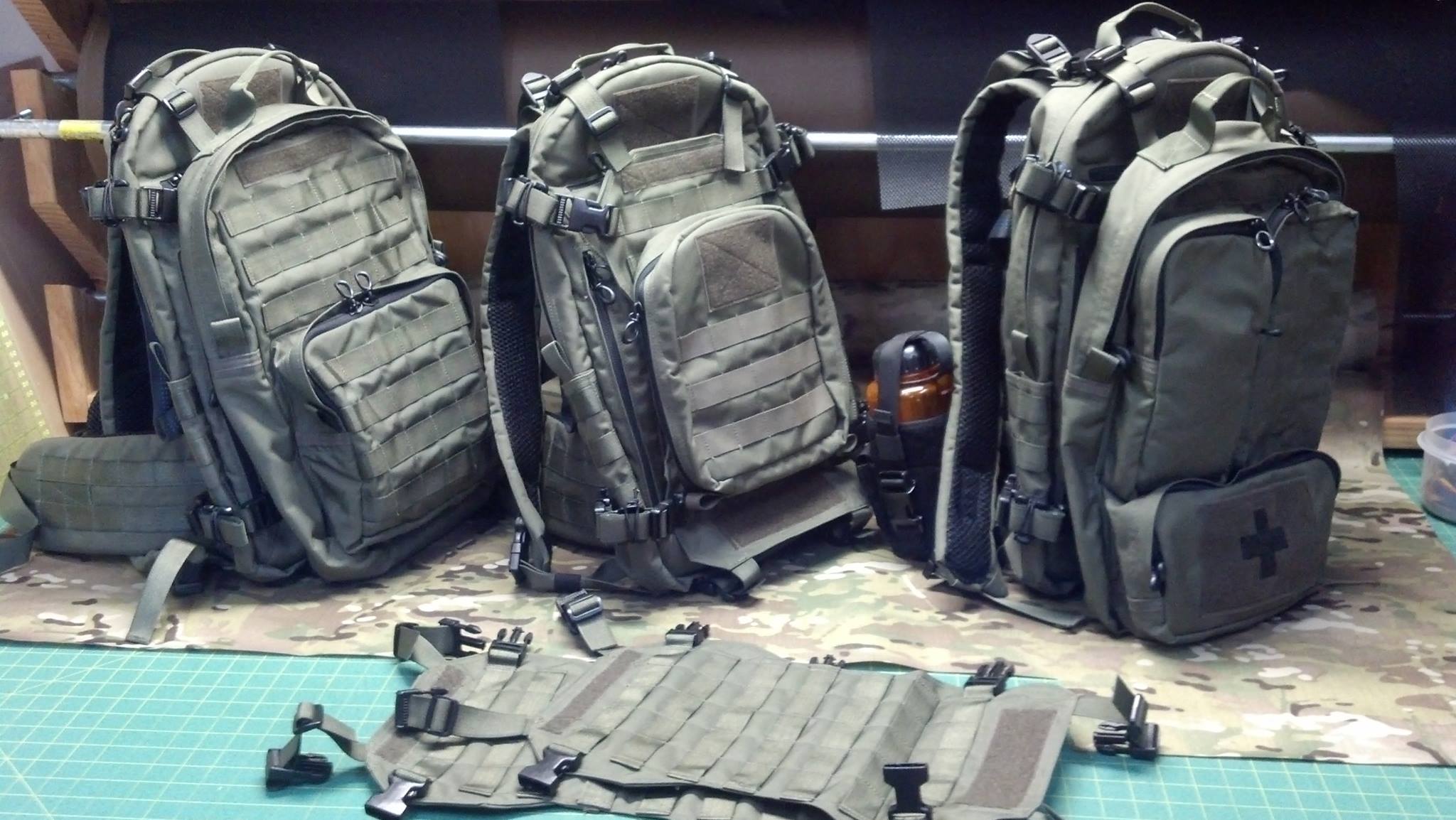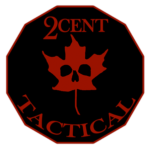With the current state of our economy, it’s always good to see companies keeping their manufacturing within North America instead of following the growing trend of outsourcing their labour and production. The major thing to consider for those who do want to start trying to manufacture goods within the United States or Canada is what pitfalls might lie ahead of them and how can they learn from the mistakes of others since it seems like every month I hear another horror story coming from friends and others within the industry. This article is going to take place in the form of an interview between Patrick York Ma from MOTUS, Prometheus Design Werx (not up at the time of writing), and formerly the founder and creator of Triple Aught Design, and Dave Watson from Fight and Flight Tactical. I picked both of these guys for the interview due to their experiences in trying to bring manufacturing back home from overseas. I do want to clarify that many countries make great gear, some of which I am proud to own. This article is about companies who are striving to keep manufacturing in the country they reside in. Making jobs within their local community.
Dave sewing the PALS webbing to the back of a few GP Medium pouches. The stick he has under the webbing adds a small gap to allow for room to insert MALICE Clips more easily.
First of all, would you guys like to tell everyone a little about yourselves?
Patrick: By the time I was 4 I had lived in 3 countries, but the rest of my youth was spent largely in the mountains of Pennsylvania and Upstate New York. I spent countless days exploring the endless woodlands of that youth. The people I grew up with showed and taught me many of the skills and fieldcraft to survive and live in the wilderness. Many of these early experiences included loading and firing a black powder muzzleloader, spotting game trails, backcountry navigation, identifying local edible plants, building shelters, properly sharpening a knife, to making and policing a campfire. I carried these learned skills as sensibilities into adulthood, as well as developing a great respect and love for the outdoors.
Being self-sufficient and prepared for the wilderness was also a state of mind that also extended to life “indoorsâ€. I had forged my own tools by the age of 12 and found myself quite drawn to spending a lot of time in the garage and workshops. I spent many years learning various fabrication techniques from foundry work, silver smithing, glass casting, woodworking, and even how to make knives under a Master Bladesmith.
Over the years I have experienced a wide variety of activities and engagements in the field from those starting in my youth: backpacking as a teen, ruck marches as a young man, and then additional recreational outdoor challenges throughout my adult life.Combined with my interests in art and design, that led me to a self-made career with the founding of my first equipment and apparel brand in 1997. Outside of my work life these days I can be found overlanding with my wife and two young boys, enjoying an overnighter with shooting buddies, or finding myself in remote parts of the world working on a wildlife conservation project.
Here you can see Patrick and his business partner Chris Whitney standing in the Prometheus Design Werx shop. Between the two they have over 40 years experience in design and fabrication.
Dave: Since I was little, I’ve been designing and building things. Legos, Construx, scrap metal and sticks, were my original medium. Then I took a drafting class in 10th grade, and things got serious. I’ve always been one to take things apart and put them back together again, learning how they work, reading books on various technologies and even primitive building techniques, storing little tidbits in my brain. My stepmom and grandmother both were master quilters, so I started sewing under her tutelage when I was 10. When I was 17, and went off to college, I got a job repairing electronics at FedEx. I even got to dabble in the design lab, helping build prototypes of new devices FedEx was looking to field. For the next several years, electronics was my medium, working on everything from PC’s to high end fiber optic routers, topping out as an Electronics Engineering Technician for Alcatel.
Then came 9/11. That day changed everything for me. In my teenage years, I seriously considered joining the Army, or even the Air Force, because I was fascinated by the warrior mindset, the camaraderie, and helicopters. About two weeks after 9/11, I walked into the recruiter’s office, hair down to my ass, and told the Staff Sergeant that I wanted to enlist. He took one look at my long hair and tried to convince me otherwise. Long story short, I shipped off to basic training a week after we put boots on the ground in Afghanistan. Because of my electronics experience, I was shuffled into aviation electrical and avionics repair, and sent to Ft. Campbell and the 101st Airborne Division. I deployed to Iraq twice, the first time being in 2003, a month before the invasion.
When I reported to Ft. Campbell, I picked up a sewing machine at the PX, and got to work doing uniform modifications, sewing on patches, and general uniform and TA-50 repair out of my barracks room. One thing led to another, and I started making my own gear, then gear for other guys in my unit. In 2007, I put up a website, and started selling my gear worldwide.
What made you initially interested in designing gear?
Patrick: The experience of understanding what worked well and what did not in the wilderness evolved into a deep interest into the design and thought process that went into the equipment and apparel created for field use. Having had an innate leaning towards creativity and fabrication, I turned those interests into a practical outlet in the form of industrial and product design later on in life. In 1997 when I founded my first brand, I was inspired to create a new niche that I felt was missing for quality products that was an amalgam or perhaps hybrid of the best the core outdoor (mountain sports) industry had to offer, yet bolstered by the very pragmatic and rugged requirements found in military and law enforcement contexts. I saw not only an opportunity to create the outdoor equipment and apparel to suit my needs and tastes, but fill a void with a distinct class of products that hadn’t been offered on the open market before.
Patrick mic’ing some lathed parts.
Dave: It started as something to make a few extra bucks, and to give myself a creative outlet. I was never a big clubber or drinker, so bar hopping just wasn’t my style. So, needless to say, I had a lot of free time for my hobby. It became apparent after a while doing gear repairs and modification, that there was a niche market for aviation gear made from durable mil-spec materials, rather than cheap import polyester, so I came up with my first few designs. From there, I started looking for needs to fill, and designed gear to fill those needs. After that, I expanded from aviation gear to more general use gear, and would bug the infantry and SF guys, asking them what gear they wish existed, but didn’t… then I’d go make it.
We live in a world of disposable goods, and I’ve always chafed at that, so my philosophy with everything I built was not to make money by building something cool that will need to be replaced in a year or two, but gear that would last.
This picture shows all the raw pieces that goes into a product. as Dave says its “A batch of 25 MK III Tactical Kneeboards on the cutting table. They will next go to be sewn, mated with clipboards and notepads, and shipped off to an Army unit at Ft. Hood.”
Why is North American manufacturing important to each of you, instead of doing what some others are and going overseas?
Patrick: Being based in the CA Bay Area, I had the great luck living in one of the original centers of outdoor product design and production. Many of the world’s leading and best know mountain brands were started right here in the Bay Area. This existing manufacturing network was literally in my backyard and gave me access to the resources, knowledge, and support that allowed me to create my first company. During the 90’s, local manufacturing in my industry was dying and being moved offshore. I knew that if I wished to succeed with my brand vision, I had to act fast and work with these remaining manufacturing resources. It was very much a symbiotic relationship; as someone who was totally learning about the industry on the fly, I was being mentored by these local businesses and in return I was giving them POs. As seasoned factories with decades of experience, they believed in what I was doing and saw their own future aligned with mine. It is this spirit of industry community that I never would have received offshore. These local factories were important to me because they my neighbours, became my friends, and my community. By supporting each other, we not to only stayed alive but over the years were able to thrive and for these factories thrive again. They believed in my vision of creating quality products that had a pride in their craftsmanship, were meant to last, and not a part of the mass market, mega volume-low cost, and disposable economy.
Chris MIGing steel fixtures.
Dave: Maybe it’s a control thing, mixed with a flexibility thing. When you outsource the production of a product, you are committed to buy a large quantity of it. If you come up with an upgrade, or modification, you’re still stuck with a thousand pieces of gear that you KNOW could be better. Doing everything in-house allows us to shift gears on the fly, and institute changes more quickly. It also gives you a lot more control on quality. If a piece of gear looks like ass, it doesn’t get shipped. If a stitch isn’t just right, it doesn’t get shipped. We really haven’t needed to outsource, and I’ve only casually investigated the possibility. I have seen the results of overseas manufacturing, and companies trying to skimp on materials to improve their bottom line, and it’s pitiful. I’ve done a lot of gear repairs and modifications, and there are companies out there who have their gear manufactured in China who use polystyrene sheets, wadded up carelessly, to pad their shoulder straps. Other companies use a single 1†square box-x stitch for a drag handle on a vest, which would not support dragging 300lbs of warfighter and gear to safety. We over-engineer our gear on purpose. If there’s a possible failure point, we reinforce it. If it’s a load-bearing point, we’re damn sure going to make it stronger. Every day I remind my employees that someone’s life may depend on the gear being built right. You can’t do that with a 3rd party sewing it.
On top of all that, America is suffering because it shifted from a production country to a consumer country. This is not sustainable. More people need to start producing goods, whether it’s garden produce and free-range eggs, starting a machine shop, or even fixing iPhones in their kitchens. The more we do locally, the stronger our economy becomes.
Now Dave you do things in house and Patrick when you were doing it you outsourced it to other manufacturers in North America, looking back are you happy with this choice or would have you done it differently?
Patrick: “Outsourcing†as you described it was really my only option. I had no investors and started my first company on $1500.00 and a few credit cards out of my garage. I did not have the capital or the resources to vertically integrate manufacturing across the 3 primary product lines I was designing and developing. These local manufacturing resources I used were by their business model, established to work with clients like myself.It took a great deal of networking to discover these resources and build these relationships, but through them I was able to offer not only hard-goods (knives and billet tools), but also soft-goods (packs and pouches) and technical performance apparel. My manufacturing relationships with these factories are actually the norm rather than the exception in the industry for brands like mine that offer a wider range of products. Not only was I happy, but felt quite fortunate that I found these manufacturers. It allowed me to get my designs to a state of tangible goods relatively quickly. I feel it would have taken me much longer to have brought my products to market had I gone through the process of amassing upwards of $1M+ to try and establish my own machine shops and sew shops.
You can see a few of the machines behind Patrick that he will be using on some of his upcoming creations at Prometheus Design Werx
Dave: Some days I wish I could just email someone my designs and let them build it. Doing all of our production in-house can be very overwhelming at times, but, given the flexibility and quality control that we have, I’m satisfied with how we’re doing it. We’ve been able to scale our production up slowly, sustainably, while building our brand name recognition. If we need more production capability, we buy another sewing machine or two, and hire a couple more stitchers. Right now we’re trying to find a larger facility, and possibly get a computerized cutting table/plotter, which will really speed up the time it takes to cut out the patterns, and reduce the risk of one of the cutters slicing a finger off.
Patrick I had talked with you a few years ago when you had a run of Stealth jackets overseas. I had asked why the move on this one product (which I own) and you had explained it was due to the lack of the technology here. Since that conversation I got one of the Stealth jackets that were made in Canada. Are we starting to see a resurgence in these technologies coming back here?
Patrick: At the time, unless you were one of the few technical sewing factories in NA which were owned by its own brand, or were prepared to run multiple thousands of a particular style, a small brand like mine did not have too many options when it came to accessing the nascent but rapidly growing “welded†construction techniques for certain kinds of technical apparel styles. Because of lower overall overhead, some of these factories overseas could offer a small brand like mine that modern manufacturing technology at production volumes and costs I could approach. These factories adopted these technologies quickly and were seemingly more nimble and agile to implement and offer them. As an example of the disparity in available fabrication technologies at that time, in the early-mid 2000’s, while even some of the best NA apparel factories were still cutting stacks of textiles with a similar process nearly a hundred years old, offshore manufacturers were integrating laser cutters.
With any newer technologies, many of the newer construction methods have become more affordable, common place and accessible with each passing year. Across the board in the past 4 years we’ve seen the re-opening of fabric mills and adoption of “modern†construction techniques. They are more widely available now than they were a few years ago in NA. Due do a number of economic and consumer trends, the move to be “Made in America†has been on the strongest rise in decades. It is a good trend to see, especially if the brand always believed in it and was part of the move to support it from the getgo, and/or to bring it back.
Old school workhorse lathe at the Prometheus Design Werx shop.
I grow tired of hearing people say “you paid how much for that?” when it comes to the gear I choose. Would you guys like to explain some of the costs that go into the whole process of creating gear to better help educate the readers in why their gear might cost as it does?
Patrick: This is an often debated, argued, and analyzed question. Many assumptions come from a very topical or ignorant understanding of manufacturing and our economies, as well as wide varying degree of consumer cultures and tastes.Take for instance; thatquality materials for manufacturing are pretty much the same costs worldwide. Wholesale Cordura nylon to the trade is going to cost you more or less the same here in NA, Germany, or Hong Kong. The biggest cost difference and factor in manufacturing is labour. Manufacturing in NA is a commitment to paying people higher wages. We live in the 1st world, there is an inherent higher cost of living; wages are proportionally higher, period. If consumers want some of their products to be made in NA, they have to understand and accept that cost and wage difference for that skilled labour.
The idea of quality and pride in manufacturing should be an attitude to be embraced no matter where it is made. It’s not an exclusively North American concept. Quality materials, construction, attention to detail, and skilled labour all cost more. They result in a wholly quality product, and yes more “expensiveâ€. Your product will last longer, perform better, and there is pride in that from both ends. As the world becomes “smaller and smallerâ€, I would like to see how each part of the world takes pride in what they make and share it with their neighbours. A consumer should buy a product because it is also the “bestâ€. Don’t give in to the wasteful mass market disposable way of consumer thinking. The “cheap and easy†culture needs to change.
Dave: As Patrick said, there are a lot of people out there making a lot of assumptions about how we price our gear. For example, the LLAMA Pack takes 12 man-hours to produce. That includes cutting, sewing, assembly, and quality control. So we have materials and labor, and we have to add to that our overhead for equipment maintenance, utilities, facility costs, advertising, and R&D costs. My employees are not “production†stitchers. Production stitchers in a large manufacturing facility super-specialize in a particular step, or even a handful of steps in the assembly process. They see the leaves. My employees are all artisans, each with 20+ years of sewing experience, and a genuine love for the art. You don’t keep employees like that at minimum wage.
Three LLAMA Packs ((Long-range Low-profile Adaptable-Mission Assault Pack) outfitted in three different configurations for demonstration with an institutional customer. From left to right: Cargo Tailgate, Standard Tailgate with a T.O.P. Pouch (Tailgate Organizer Pouch), and a Medical Tailgate. The far right LLAMA also has a TJRS (Tactical Java Retention System) attached, carrying a 1qt Nalgene bottle. In the foreground are the two Standard Tailgates removed from the packs with the Mission Tailgates installed.
I know both of you have suffered both victory and setbacks. Would you like to elaborate on some of the pitfalls you have suffered through your journeys? This will better help those who are interested in joining the industry.
Patrick: It’s a long list, but fortunately more victories than setbacks. Otherwise the business would have failed. In general even the greatest of ideas are worthless unless you have the grit and wherewithal to turn it into reality. Pitfalls happen from poor planning, ignorance and at times unforeseen external machinations. Instead of elaborating on specific pitfalls, let’s focus on the basics and mindset of how to achieve the wins. That is probably the better message.
Have the utter, unwavering commitment to make your vision a reality. Be passionate in what you do. Follow your own vision and not someone else’s. Don’t do anything designed by committee. Follow through and don’t make promises you can’t back up and keep. Chances are that your gut and heart are telling you the truth most of the time. While they may not seem like they are worth it at the time, retain that highly competent attorney to protect your personal and business interests. Don’t get high and mighty on your own good press, and keep it real and grounded. In many instances when getting started, you have no one to rely on but yourself. There is no free lunch. Treat your employees with respect, and never forget the friends and customers who helped you and made your business what it is. No matter what you do, don’t give up. Find a way or make one.
Dave: We’ve had our share of setbacks, most recently last year, when we picked up a new materials supplier who also wanted to distribute our products. They ended up rebranding our products and selling them as their own; shipping us materials we didn’t order and charging us for them, while not shipping us the parts we DID need; then never paid us for a single finished product. Long story short, we ended up out over $10 grand in finished goods, backlogged on production and prototyping of new products, and ended up having to cut staff to make up the shortfall. We’re still recovering from that one. Lesson learned from that one? Don’t trust anyone without legal papers to back up things. If someone smells fishy, they likely are.
Do you find that either through taxation or legislation, certain states or the country as a whole makes it almost cost prohibitive for manufacturers?
Patrick: Yes.Many of us were brought up with the idea that may the “best man winâ€, and if I lost, I will do my damnedest to win the next time. Those who only wish to protect their corporate interests pass so many of today’s laws and legislation. It’s hurts and represses the small business, entrepreneur, kills wide spread innovation, and prevents segments of manufacturing from even getting off the ground.
Dave: Absolutely yes. Right now, we do not have a store front. We operate out of my private property, and rarely entertain customers on the premises. In fact, if you didn’t know any better, you wouldn’t even know there was a business here, except for the daily FedEx and UPS deliveries, and several cars in the oversized driveway. Despite this, our town zoning board wants to push extra taxes and restrictions on us. We use zero business services provided by the city. We have no grants, loans, subsidies, or tax breaks. We DO provide jobs for local people who wouldn’t have a job otherwise. Because of this, combined with serious issues with the Kentucky state gov’t, we’re in the planning stages of moving the business to Texas. We’ll have to hire and train all new stitchers, but it will be worth it in the long run.
At the state and Federal level, the tax code is incomprehensible. I’m a pretty smart guy, and I can’t figure it out. The rules overlap, contradict themselves, and getting help from the various agencies is little to no help, either, and if they steer you wrong, it’s still on the business owner.
If the government were to make one change, what would help push others to either produce products here, or help the ones who already are?
Patrick: I never asked or received a lick of help from the gov’t in the process of creating my business or networking with my manufacturers. If anything, I want them out of my way. If there is one broad thing the gov’t could do, I would say it’s to prevent corporate law from actually trumping and superseding the constitution and the fundamental tenants of the Declaration of Independence for the individual.
Dave: Unlike Patrick, I do receive a small lick of help from the gov’t, but that’s just my VA disability check. Otherwise, I’ve built this business from the ground up all on my own.What governments need to do is just get out of the way. Let us do our thing, and we’ll provide jobs and products to stimulate the economy. I’m a student of the Constitution, history, socioeconomic theory, etc, and the system we live in is not capitalism, despite what many people think… for the past 100 years or so, we’ve been in a fascist economic system. I know that sounds like crazy talk, but Google it, you’ll see that I’m right.
Right now workers are clamoring for higher minimum wages, in order to keep up with inflation. That’s like treating a bullet wound by pumping in more units of blood, but not stopping the bleeding. The problem is inflation. The way to stop that is to audit and eliminate the Federal Reserve, and go back to a monetary system based on tangible assets, rather than the “good faith and confidence†of a political entity. I know I kind of gave a long answer for a short question there, but the short answer would be America and the several states to return to a sound monetary policy.
Do you guys have anything you want to end this article on?
Patrick: Follow your heart, don’t lose your soul, believe in your vision, fight hard, work hard, and play hard.
Dave: Do what you do, do it well, always strive to do better, do it honestly, and success will follow.
I would personally like to thank Dave and Patrick for being a part of this project. I would also like to thank Dave for the pictures of his work and for Patrick and Chris Van Loan/TALUS Photography for the pictures at his shop. I hope to have several other articles in this series covering both gear and firearms parts and accessories.


